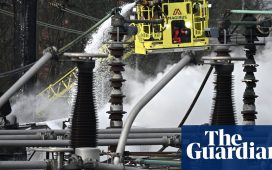India is close to completing its most advanced nuclear plant, marking a major step forward in the country’s nuclear energy programme.
The Prototype Fast Breeder Reactor (PFBR) at Kalpakkam in the southern state of Tamil Nadu has received approval from the country’s atomic regulator to begin loading nuclear fuel.
The PFBR is a 500MW liquid sodium-cooled reactor which has been in development for the past 20 years. This approval marks the start of a controlled chain reaction in India’s most advanced and complex nuclear reactor.
While there have been concerns over the use of sodium, a hazardous material, as a coolant, the country’s atomic board said it has conducted safety reviews and assessments of the PFBR, complemented by periodic inspections.
Once operational, India will join Russia as the only two countries in the world with commercially operating fast breeder reactors.
“It is a huge milestone for India’s self-reliant atomic energy programme,” Dinesh Kumar Shukla, chairman of the Atomic Energy Regulatory Board (AERB) said, according to NDTV.
Mr Shukla said the PFBR is an “inherently safe reactor”.
The PFBR has been entirely designed and constructed domestically, with contributions from over 200 Indian industries, keeping the Indian government’s push for self-reliance in mind.
Due to its complexity and the need for indigenous technology, the project has faced delays and cost overruns, now amounting to ₹68,400m (£651.43m).
The Department of Atomic Energy (DAE) states that the PFBR, a third-generation reactor with passive safety features, ensures safe shutdowns in emergencies. It utilises spent fuel from India’s nuclear programme, reducing nuclear waste, and the need for geological disposal.
Despite its advanced technology, the PFBR’s capital and electricity costs are comparable to other nuclear and conventional power plants.
The PFBR’s approval also signifies India’s use of plutonium as a nuclear fuel and paves the way for the future use of thorium, a resource in which India has abundant reserves.
Unlike uranium, which is limited in India, thorium presents an opportunity for long-term energy independence, potentially lasting over 300 years. Experts believe that mastering the technology to use thorium could secure India’s energy future.
Fast breeder reactors, like the PFBR, are unique because they generate more fuel than they consume, earning them the reputation of being an almost limitless energy source.
The term “fast” refers to the high-energy fast neutrons used in these reactors. India already operates a Fast Breeder Test Reactor (FBTR) at the same location, which has been functional for 39 years.
The board’s approval allows for the commencement of fuel loading and low-power physics experiments, with the reactor expected to become operational in the coming months.
The PFBR will initially use Uranium-Plutonium Mixed Oxide (MOX) fuel. A uranium-238 “blanket” surrounding the core will produce more fuel through nuclear transmutation. This process, known as breeding, is what gives these reactors their name.
In the future, thorium-232 may also be used as a blanket, creating fissile uranium-233 through transmutation, which will be utilised in the third stage of India’s nuclear programme. This stage is crucial for harnessing India’s vast thorium reserves.
Nuclear energy is considered a reliable and low-carbon source of electricity, helping to reduce greenhouse gas emissions that cause climate crisis and diversifying energy supply. However, there are concerns regarding safety and waste that researchers are trying to overcome with new technology.
Recently China unveiled the world’s first “meltdown-proof” nuclear power plant.
So far, nuclear energy only accounts for 3.11 per cent of the country’s total power generation. But India aims to have nuclear power account for nearly 9 per cent of its electricity by 2047 and it is rapidly investing in the technology.
While presenting India’s latest annual budget, finance minister Nirmala Sitharaman told parliament that nuclear energy would “form a very significant part of the energy mix” for India’s development.
The government plans to increase India’s nuclear power capacity from 6,780MW to 22,480MW by 2031. This will involve building 18 new reactors that can produce a total of 13.8GW of electricity. After PFBR, two more fast breeder reactors are in the pipeline.











